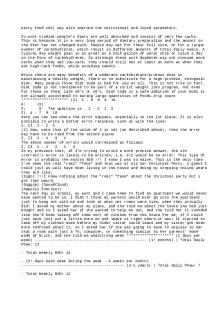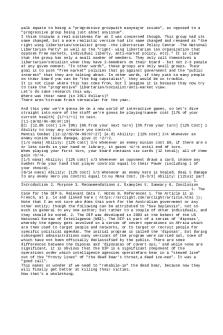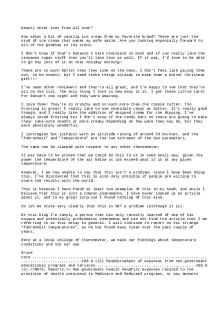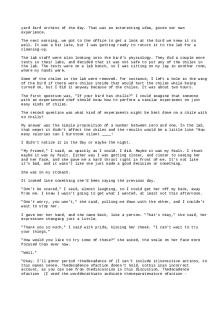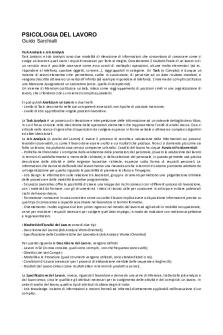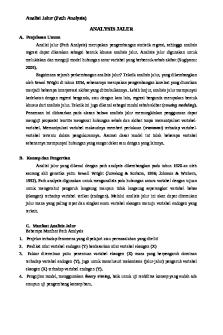Acoby Analysis PDF

| Title | Acoby Analysis |
|---|---|
| Course | Crime and Society |
| Institution | Trent University |
| Pages | 6 |
| File Size | 82.7 KB |
| File Type | |
| Total Downloads | 42 |
| Total Views | 149 |
Summary
Analysis of female criminal...
Description
Running head: Canada’s Most Dangerous Female Offender—Deficient Social Bonds
Canada’s Most Dangerous Female Offender—Deficient Social Bonds Study: Renee Acoby SOCI 2615H
1
Running head: Canada’s Most Dangerous Female Offender—Deficient Social Bonds
2
The case study of Renee Acoby, one of Canada’s female dangerous offenders can be connected to control theories of criminology, more specifically Travis Hirschi’s Social Bond Theory. Control theories indicate that individuals are deterred from criminal behaviour because of factors that control their impulses to break any social norms (Lilly, et al, 2015). In Acboy’s case, she lacked many of these crime deterrence’s and therefore had more impulse to break social norms. In Hirschi’s social bond theory, using the four social bonds indicates an individuals level of participation in criminal behaviour. If an individual lacks one or more of these social bonds, they are at a higher risk of criminal behaviour. In Acoby’s case, she possesses a lack of all four social bonds. Using Hirschi’s social bond theory can be an effective way to understand the criminal behaviour of Renee Acoby. This will be demonstrated through an analysis of the four social bonds; attachment, commitment, involvement and belief, with a comparison to Acoby. Renee Acoby was declared a dangerous offender as of 2011, which Public Safety of Canada defined as “individuals convicted of these offences can be designated as a Dangerous Offender during sentencing if a sentencing court is satisfied that the offender constitutes a threat to the life, safety or physical or mental well-being of the public” (Public Safety Canada, 2015). Acoby is a 39 year old Ojibwa woman, mother and poet, on top of her dangerous offender title. She was born in Manitoba and lived with two siblings and her grandmother, who at the time, she thought was her mother. When Acoby was just 6 months old, her father beat her mother to death, causing her to be released into her grandmother’s care. She did not learn about this until she was a preteen, where she became violent and eventually was diagnosed with conduct disorder (Lasalle, 2017). Her violent behaviour into her teen years found her in and out of jail, foster care and group
Running head: Canada’s Most Dangerous Female Offender—Deficient Social Bonds
3
homes where she only participated in more criminal behaviour. In 2000, Acoby was convicted of assault with a weapon and drug trafficking and sentenced to three and a half years in federal prison, while pregnant. She gave birth to her daughter that same year and began to earn her dangerous offender title shortly after that. At 21 years old, her daughter was removed from her care and placed with her sister, which caused for her to anger and act out. Throughout her time in prison, she has been convicted of five-hostage takings, which added 18 years on to her 3 and a half-year original sentence and gave her the dangerous offender title. Acoby believes that her reason to offend stems from being overly controlled in the system, which her conduct disorder does not agree with. Travis Hirschi’s social bond theory identifies four social bonds that individuals possess when they are less likely to participate in criminal behaviour. These are, attachment; to families, teachers and other guardians, commitment; to social norms and institutions such as school, involvement; in activities such as sports, and belief; that these are important to a society (Lilly, et al, p.120). When an individual lacks one or more of these, they are more likely to participate in criminal behaviour. Social bond theory can be used to explain the criminal behaviour of Renee Acoby. To begin with the analysis, Acoby relates to the first social bond discussed by Hirschi called attachment through the lack of closeness she possessed with her parents. Her anger with her grandmother became so strong that she was no longer concerned with disappointing family, and it gave her more reason behave criminally. Hirschi states “ Youths do not offend because they do not want to disappoint their parents (or whom they are attached, such as teachers)” (Lilly, et al, p. 120). It is likely that this is where her involvement in crime stemmed from, leading her into the federal prison system.
Running head: Canada’s Most Dangerous Female Offender—Deficient Social Bonds
4
Acoby also possesses a lack of commitment due to her upbringing being in and out of foster care or time spent in jail, she had very minimal academic future at stake and therefore nothing was really preventing her in that sense. She lacked rational thought in that sense due to her upbringing and diagnosis of conduct disorder as well as the grades to obtain strong occupational aspirations (Lasalle, 2017). The third social bond, involvement was also lacking in Acoby’s upbringing. As Hirschi explained it, was a way of saying there was a lack of criminal opportunities, therefore making delinquency less likely (Lilly, et al, p.121). Acoby had more access to criminal opportunities if anything and therefore lived in delinquency. Her involvement in delinquent behaviour such as; drinking, getting into trouble as a teenager, jail time and group homes took away from her access to activity and therefore she had more time to pursue criminal behavior. Finally, the fourth social bond called belief is present in the current life as well as the past life of Renee Acoby. Due to her conduct disorder she may have possessed some anger toward the law as conduct disorder possesses behaviour issues. She lacks a belief in the law if she is willing or even eager to participate in activities that could get her into trouble with the law, therefore she has minimal restrain because she has deviant impulses and limited belief in the law or even norms and rules. Acoby possessed a lack of reinforcement of the laws, rules, and norms, where Hirschi would indicate that it became easier to defy them due to a lack of parental reinforcement (Lilly, et al, p.122). Hirschi would argue that her lack of attachment, and therefore lack of social support systems makes her more susceptible to criminal behaviour. In conclusion, control theories can be used to explain the criminal behaviour possessed by Renee Acoby. More specifically, the extension of the Social Bond Theory
Running head: Canada’s Most Dangerous Female Offender—Deficient Social Bonds by Travis Hirschi can help identify the aspects of Acoby’s behaviour in which lack the social bonds to gain a better understanding as to why she committed the crimes she did.
References Lasalle, L. (2017, November 30). Meet Renee Acoby: In-House Female Dangerous Offender. Retrieved March 17, 2017, from http://thetroublewithjustice.com/2014/06/25/meet-renee-acoby-in-house-femaledangerous-offender/
5
Running head: Canada’s Most Dangerous Female Offender—Deficient Social Bonds Lilly, J., Ball, R.A., & Cullen, F.T. (2015). Criminological Theory: context and consequences. Los Angeles: Sage. Public Safety Canada. (2015, November 26). Dangerous offender designation. Retrieved March 17, 2018, from https://www.publicsafety.gc.ca/cnt/cntrngcrm/crrctns/protctn-gnst-hgh-rsk-ffndrs/dngrs-ffndr-dsgntn-en.aspx
6...
Similar Free PDFs
Popular Institutions
- Tinajero National High School - Annex
- Politeknik Caltex Riau
- Yokohama City University
- SGT University
- University of Al-Qadisiyah
- Divine Word College of Vigan
- Techniek College Rotterdam
- Universidade de Santiago
- Universiti Teknologi MARA Cawangan Johor Kampus Pasir Gudang
- Poltekkes Kemenkes Yogyakarta
- Baguio City National High School
- Colegio san marcos
- preparatoria uno
- Centro de Bachillerato Tecnológico Industrial y de Servicios No. 107
- Dalian Maritime University
- Quang Trung Secondary School
- Colegio Tecnológico en Informática
- Corporación Regional de Educación Superior
- Grupo CEDVA
- Dar Al Uloom University
- Centro de Estudios Preuniversitarios de la Universidad Nacional de Ingeniería
- 上智大学
- Aakash International School, Nuna Majara
- San Felipe Neri Catholic School
- Kang Chiao International School - New Taipei City
- Misamis Occidental National High School
- Institución Educativa Escuela Normal Juan Ladrilleros
- Kolehiyo ng Pantukan
- Batanes State College
- Instituto Continental
- Sekolah Menengah Kejuruan Kesehatan Kaltara (Tarakan)
- Colegio de La Inmaculada Concepcion - Cebu

